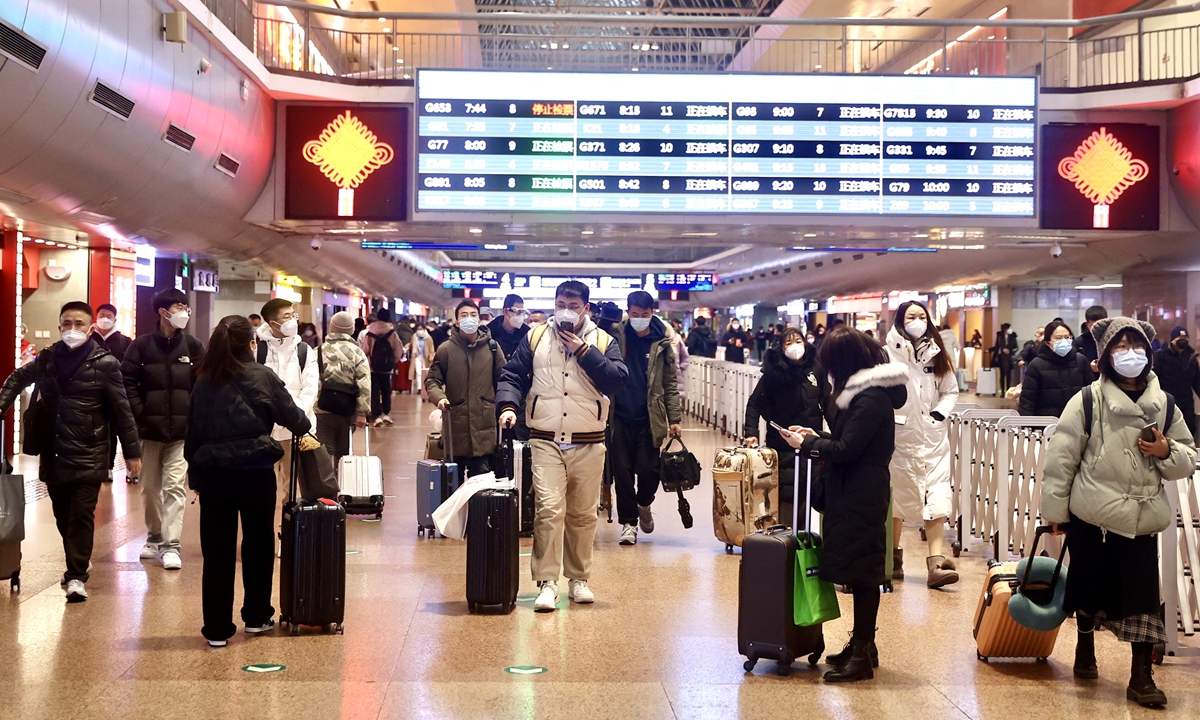
People wait for trains at the Beijing West Railway Station during the peak travel rush for the upcoming Chinese New Year holidays on January 16, 2023. China's 40-day Chunyun or Spring Festival travel rush, the world's largest human migration, is expected to see about 2.09 billion passenger trips from January 7 until February 15. Photo: VCG
With a huge passenger flow of about 5 billion trips expected during this year's Chinese Lunar New Year, COVID infection numbers in certain specific regions could rise, but the possibility of a large-scale epidemic rebound nationwide in the next two to three months is low, Wu Zunyou, chief epidemiologist of the Chinese Center for Disease Control and Prevention (China's CDC), wrote on his social media account Saturday.
Responding to the Deltacron variant that recently sparked public concern, Wu noted that China has not found the variant so far. Given that it was spotted almost a year ago but has not spread on a global scale, it is unlikely the Deltacron would trigger a new round of pandemic in the near future.
After China optimized epidemic prevention and control measures, COVID infections soared across the nation rapidly but has now passed the peak. Cities of various scales nationwide as well as counties are now seeing decline of the infections, the epidemiologist said.
This wave of epidemic in China is mainly caused by multiple sub-branches of the Omicron strain, among which the BA.5.2 is absolutely dominant, followed by the BF.7 and the BA.2.76, with more than a dozen other subtypes accounting for less than 5 percent of the total.
As some expressed worries that the Spring Festival travel rush could trigger an epidemic rebound, Wu reassured that although the large movement of people during the holidays could to some extent cause the spread of epidemic and a rise in the number of infections in some places, the likelihood of a large nationwide rebound or a second wave in the next two to three months is small, as this wave of the epidemic has already infected about 80 percent of the population.
Regarding the epidemic situations overseas, Wu said the virus strains currently circulating in the US are BQ.1, BQ.1.1, and XBB.1.5 variants, of which XBB.1.5 saw a rapid increase in infections in December last year and early January this year, drawing concerns worldwide.
Some Chinese cities have also detected XBB.1.5 variant in imported cases, but the variant hasn't been detected in local cases so far. Although the XBB.1.5 variant has been imported to China, it is unlikely to spread in the country and trigger a new wave of outbreaks in the short term.
As for the Deltacron variant recently found in Thailand that has caught attention from the Chinese public, Wu noted the variant has long been detected in Europe and some African countries a year ago.
The mutant strain has not been monitored in China. Due to the low number of infections, data on the transmission, pathogenicity and immune escape capacity of this strain are still lacking.
Wu's remarks came one day ahead of the grandest annual event for Chinese people - the Chinese Lunar New Year. He reminded that people who have not fully recovered from COVID are not advised to visit relatives and friends during the Spring Festival holidays.
For middle-aged and senior citizens who have already been infected and appeared to have "recovered," their body functions have not fully returned to the pre-infection levels, so they are not recommended to travel long-distance during the holidays. Avoid staying up late or drinking too much alcohol when gathering with friends and relatives, he wrote.
Family members should closely monitor the physical changes of their elderly family members. Once the elderly show repeated or aggravated symptoms, they should be sent to the hospital immediately.




